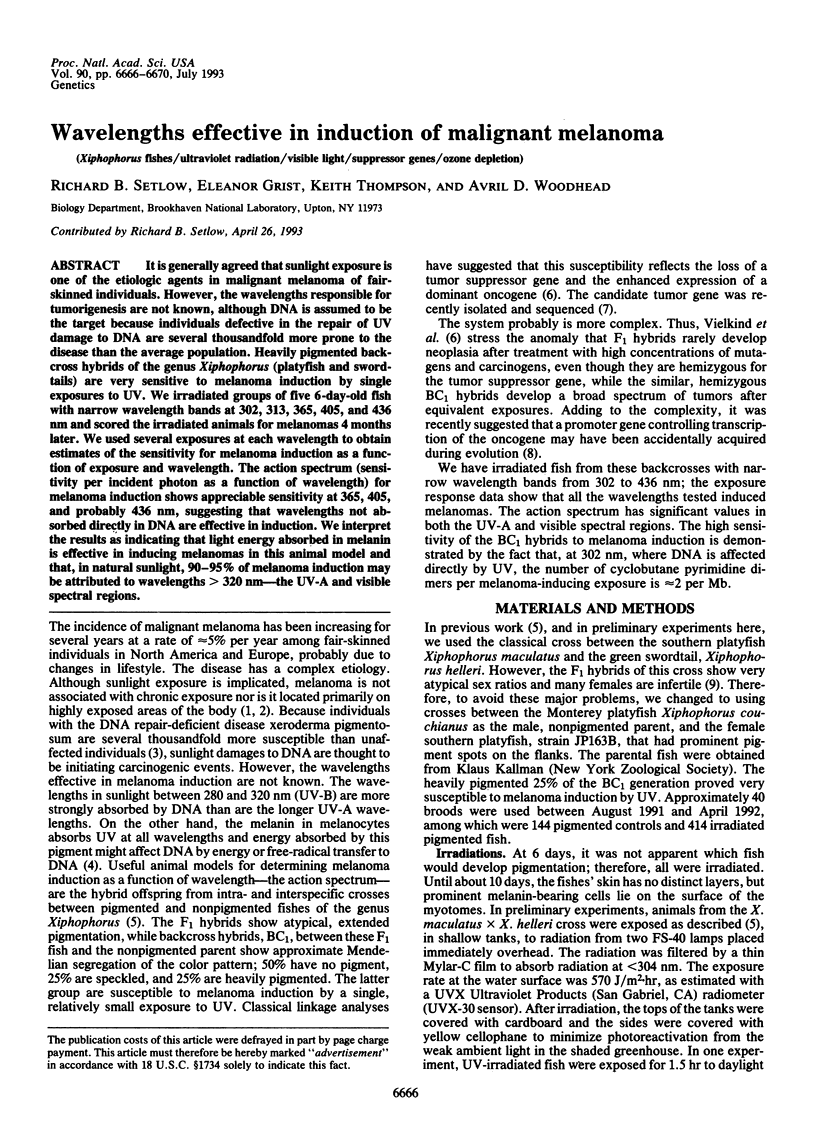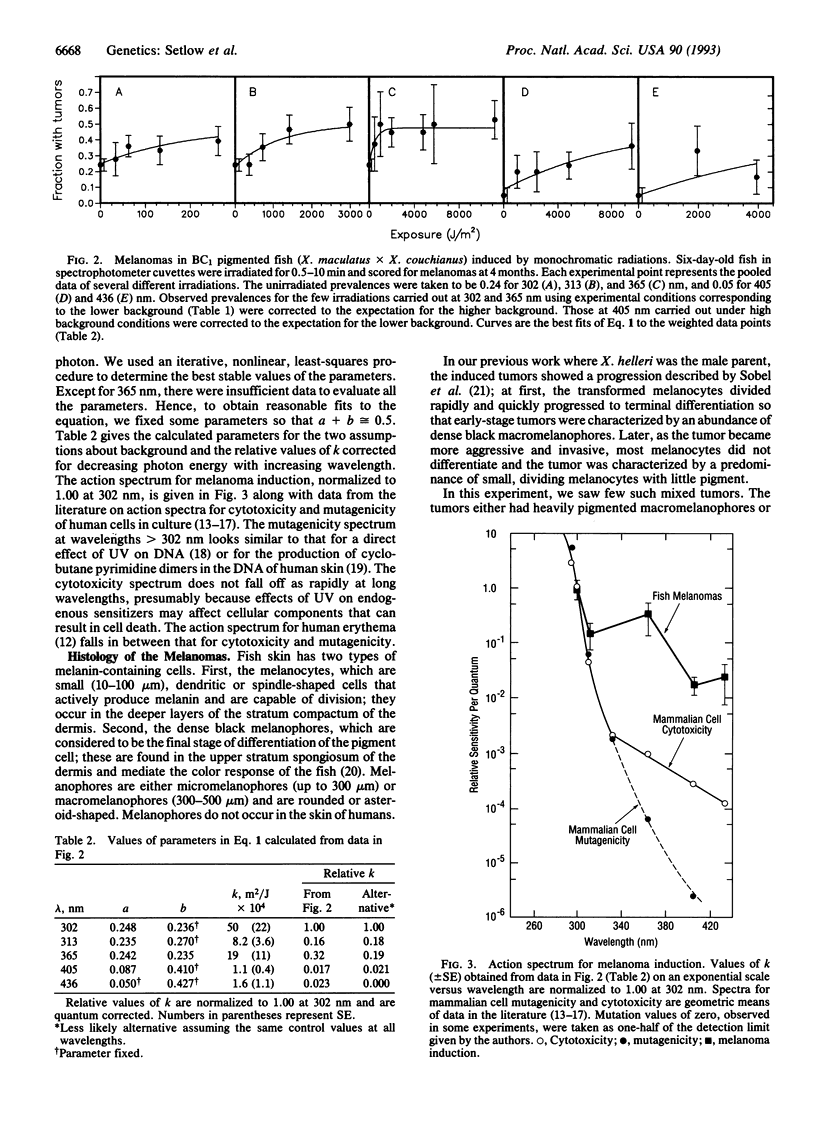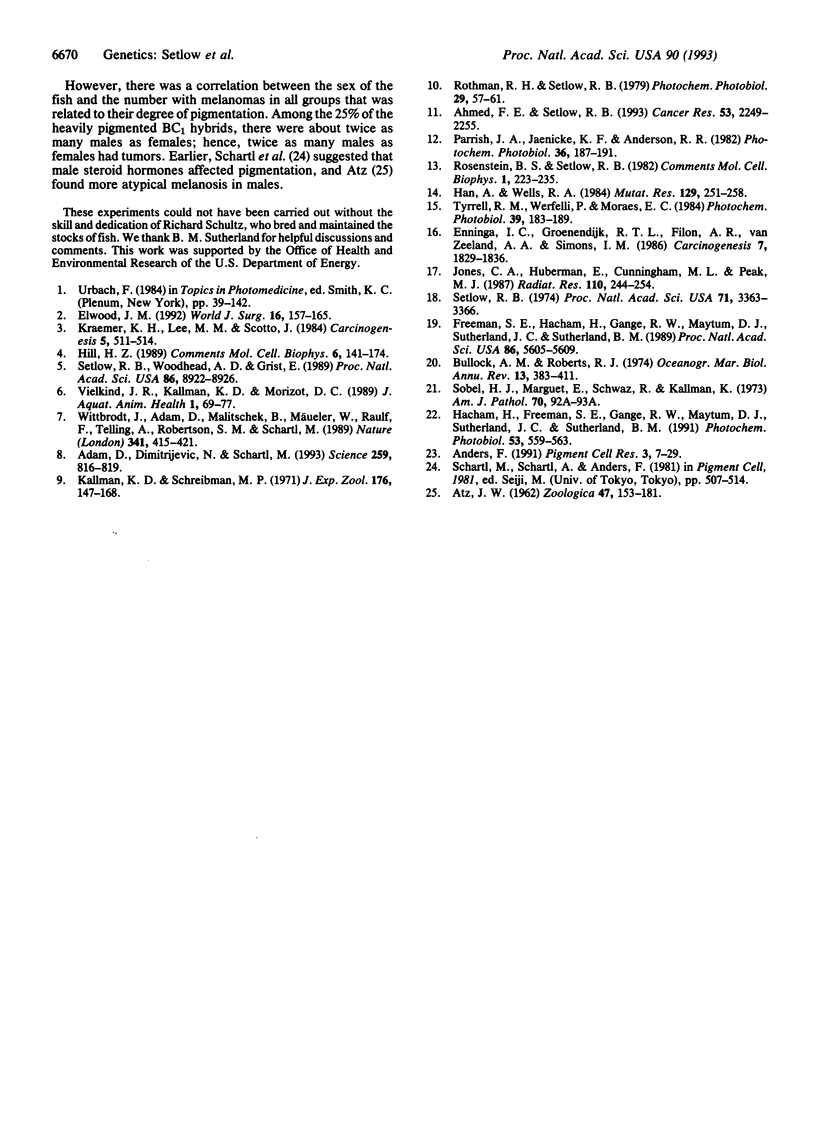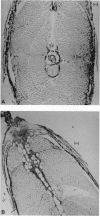Abstract
It is generally agreed that sunlight exposure is one of the etiologic agents in malignant melanoma of fair-skinned individuals. However, the wavelengths responsible for tumorigenesis are not known, although DNA is assumed to be the target because individuals defective in the repair of UV damage to DNA are several thousandfold more prone to the disease than the average population. Heavily pigmented backcross hybrids of the genus Xiphophorus (platyfish and swordtails) are very sensitive to melanoma induction by single exposures to UV. We irradiated groups of five 6-day-old fish with narrow wavelength bands at 302, 313, 365, 405, and 436 nm and scored the irradiated animals for melanomas 4 months later. We used several exposures at each wavelength to obtain estimates of the sensitivity for melanoma induction as a function of exposure and wavelength. The action spectrum (sensitivity per incident photon as a function of wavelength) for melanoma induction shows appreciable sensitivity at 365, 405, and probably 436 nm, suggesting that wavelengths not absorbed directly in DNA are effective in induction. We interpret the results as indicating that light energy absorbed in melanin is effective in inducing melanomas in this animal model and that, in natural sunlight, 90-95% of melanoma induction may be attributed to wavelengths > 320 nm--the UV-A and visible spectral regions.
Full text
PDF




Images in this article
Selected References
These references are in PubMed. This may not be the complete list of references from this article.
- Adam D., Dimitrijevic N., Schartl M. Tumor suppression in Xiphophorus by an accidentally acquired promoter. Science. 1993 Feb 5;259(5096):816–819. doi: 10.1126/science.8430335. [DOI] [PubMed] [Google Scholar]
- Ahmed F. E., Setlow R. B. Ultraviolet radiation-induced DNA damage and its photorepair in the skin of the platyfish Xiphophorus. Cancer Res. 1993 May 15;53(10 Suppl):2249–2255. [PubMed] [Google Scholar]
- Anders F. Contributions of the Gordon-Kosswig melanoma system to the present concept of neoplasia. Pigment Cell Res. 1991 Feb;4(1):7–29. doi: 10.1111/j.1600-0749.1991.tb00309.x. [DOI] [PubMed] [Google Scholar]
- Elwood J. M. Melanoma and sun exposure: contrasts between intermittent and chronic exposure. World J Surg. 1992 Mar-Apr;16(2):157–165. doi: 10.1007/BF02071515. [DOI] [PubMed] [Google Scholar]
- Enninga I. C., Groenendijk R. T., Filon A. R., van Zeeland A. A., Simons J. W. The wavelength dependence of u.v.-induced pyrimidine dimer formation, cell killing and mutation induction in human diploid skin fibroblasts. Carcinogenesis. 1986 Nov;7(11):1829–1836. doi: 10.1093/carcin/7.11.1829. [DOI] [PubMed] [Google Scholar]
- Freeman S. E., Hacham H., Gange R. W., Maytum D. J., Sutherland J. C., Sutherland B. M. Wavelength dependence of pyrimidine dimer formation in DNA of human skin irradiated in situ with ultraviolet light. Proc Natl Acad Sci U S A. 1989 Jul;86(14):5605–5609. doi: 10.1073/pnas.86.14.5605. [DOI] [PMC free article] [PubMed] [Google Scholar]
- Hacham H., Freeman S. E., Gange R. W., Maytum D. J., Sutherland J. C., Sutherland B. M. Do pyrimidine dimer yields correlate with erythema induction in human skin irradiated in situ with ultraviolet light (275-365 nm)? Photochem Photobiol. 1991 Apr;53(4):559–563. doi: 10.1111/j.1751-1097.1991.tb03671.x. [DOI] [PubMed] [Google Scholar]
- Jones C. A., Huberman E., Cunningham M. L., Peak M. J. Mutagenesis and cytotoxicity in human epithelial cells by far- and near-ultraviolet radiations: action spectra. Radiat Res. 1987 May;110(2):244–254. [PubMed] [Google Scholar]
- Kallman K. D., Schreibman M. P. The origin and possible genetic control of new, stable pigment patterns in the poeciliid fish Xiphophorus maculatus. J Exp Zool. 1971 Feb;176(2):147–168. doi: 10.1002/jez.1401760204. [DOI] [PubMed] [Google Scholar]
- Kraemer K. H., Lee M. M., Scotto J. DNA repair protects against cutaneous and internal neoplasia: evidence from xeroderma pigmentosum. Carcinogenesis. 1984 Apr;5(4):511–514. doi: 10.1093/carcin/5.4.511. [DOI] [PubMed] [Google Scholar]
- Parrish J. A., Jaenicke K. F., Anderson R. R. Erythema and melanogenesis action spectra of normal human skin. Photochem Photobiol. 1982 Aug;36(2):187–191. doi: 10.1111/j.1751-1097.1982.tb04362.x. [DOI] [PubMed] [Google Scholar]
- Setlow R. B. The wavelengths in sunlight effective in producing skin cancer: a theoretical analysis. Proc Natl Acad Sci U S A. 1974 Sep;71(9):3363–3366. doi: 10.1073/pnas.71.9.3363. [DOI] [PMC free article] [PubMed] [Google Scholar]
- Setlow R. B., Woodhead A. D., Grist E. Animal model for ultraviolet radiation-induced melanoma: platyfish-swordtail hybrid. Proc Natl Acad Sci U S A. 1989 Nov;86(22):8922–8926. doi: 10.1073/pnas.86.22.8922. [DOI] [PMC free article] [PubMed] [Google Scholar]
- Tyrrell R. M., Werfelli P., Moraes E. C. Lethal action of ultraviolet and visible (blue-violet) radiations at defined wavelengths on human lymphoblastoid cells: action spectra and interaction sites. Photochem Photobiol. 1984 Feb;39(2):183–189. doi: 10.1111/j.1751-1097.1984.tb03426.x. [DOI] [PubMed] [Google Scholar]
- Wells R. L., Han A. Action spectra for killing and mutation of Chinese hamster cells exposed to mid- and near-ultraviolet monochromatic light. Mutat Res. 1984 Nov;129(2):251–258. doi: 10.1016/0027-5107(84)90158-1. [DOI] [PubMed] [Google Scholar]
- Wittbrodt J., Adam D., Malitschek B., Mäueler W., Raulf F., Telling A., Robertson S. M., Schartl M. Novel putative receptor tyrosine kinase encoded by the melanoma-inducing Tu locus in Xiphophorus. Nature. 1989 Oct 5;341(6241):415–421. doi: 10.1038/341415a0. [DOI] [PubMed] [Google Scholar]



